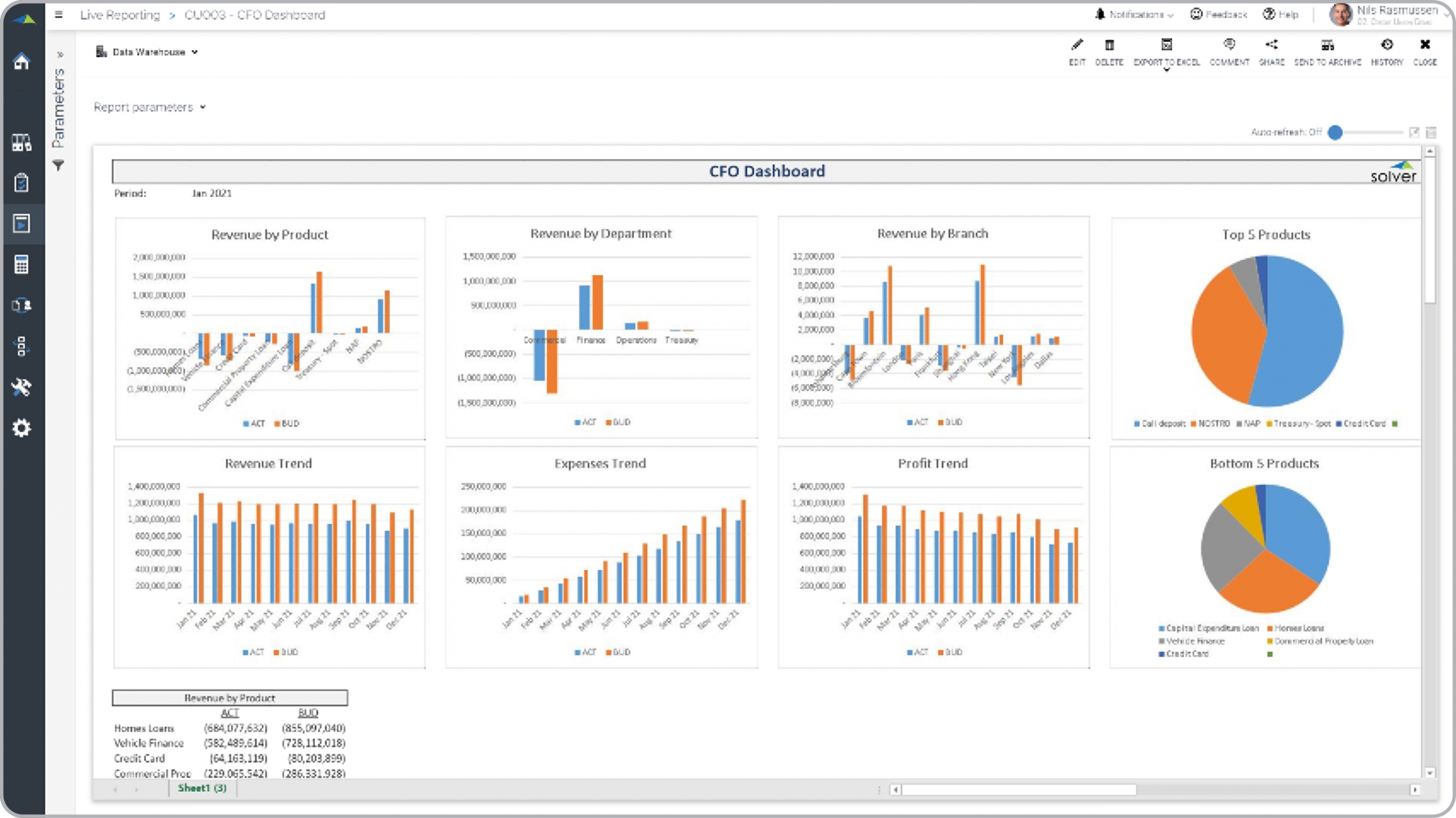CFO Dashboard for Credit Unions
What is
a
CFO Dashboard
? CFO Dashboards are considered financial analysis tools and are used by CFOs and financial managers to monitor trends and budget variances for key financial metrics. Some of the main functionality in this type of dashboard is that it provides graphical analysis of eight different metrics, including: 1) Actual versus budgeted revenues by product, 2) Monthly revenue trend, 3) Actual and budget revenue comparison for departments, 4) Monthly expense trend, 5) Actual and budget revenue comparison by branch, 6) Monthly profit trend, 7) Top products by revenue, and 8) Bottom products by revenue. You find an example of this type of dashboard below.
Purpose of
CFO Dashboards Credit Unions use CFO Dashboards to enable financial leaders to look beyond classic financial statements in their analysis. When used as part of good business practices in Financial Planning & Analysis (FP&A) departments, a company can improve its expense control and profitability, and it can reduce the chances that any important outliers or trends are detected too late for corrective decisions.
Example of a
CFO Dashboard Here is an example of a Credit Union CFO Dashboard for actual and budget comparisons and trend analysis as well as actual to budget comparisons. [caption id="" align="alignnone" width="2560"]
 Example of a CFO Dashboard for Credit Unions[/caption] You can find hundreds of additional examples
here
Who Uses This Type of
Dashboard
? The typical users of this type of dashboard are: CFOs, Analysts, Product Managers, Budget Managers.
Other Reports Often Used in Conjunction with
CFO Dashboards Progressive Financial Planning & Analysis (FP&A) departments sometimes use several different Financial Dashboards, along with profit & loss reports, balance sheets, cash flow statements, budget models, forecasts and other management and control tools.
Where Does the Data for Analysis Originate From? The Actual (historical transactions) data typically comes from enterprise resource planning (ERP) systems like: Microsoft Dynamics 365 (D365) Finance, Microsoft Dynamics 365 Business Central (D365 BC), Microsoft Dynamics AX, Microsoft Dynamics NAV, Microsoft Dynamics GP, Microsoft Dynamics SL, Sage Intacct, Sage 100, Sage 300, Sage 500, Sage X3, SAP Business One, SAP ByDesign, Acumatica, Netsuite and others. In analyses where budgets or forecasts are used, the planning data most often originates from in-house Excel spreadsheet models or from professional corporate performance management (CPM/EPM) solutions.
What Tools are Typically used for Reporting, Planning and Dashboards? Examples of business software used with the data and ERPs mentioned above are:
Example of a CFO Dashboard for Credit Unions[/caption] You can find hundreds of additional examples
here
Who Uses This Type of
Dashboard
? The typical users of this type of dashboard are: CFOs, Analysts, Product Managers, Budget Managers.
Other Reports Often Used in Conjunction with
CFO Dashboards Progressive Financial Planning & Analysis (FP&A) departments sometimes use several different Financial Dashboards, along with profit & loss reports, balance sheets, cash flow statements, budget models, forecasts and other management and control tools.
Where Does the Data for Analysis Originate From? The Actual (historical transactions) data typically comes from enterprise resource planning (ERP) systems like: Microsoft Dynamics 365 (D365) Finance, Microsoft Dynamics 365 Business Central (D365 BC), Microsoft Dynamics AX, Microsoft Dynamics NAV, Microsoft Dynamics GP, Microsoft Dynamics SL, Sage Intacct, Sage 100, Sage 300, Sage 500, Sage X3, SAP Business One, SAP ByDesign, Acumatica, Netsuite and others. In analyses where budgets or forecasts are used, the planning data most often originates from in-house Excel spreadsheet models or from professional corporate performance management (CPM/EPM) solutions.
What Tools are Typically used for Reporting, Planning and Dashboards? Examples of business software used with the data and ERPs mentioned above are:
- Native ERP report writers and query tools
- Spreadsheets (for example Microsoft Excel)
- Corporate Performance Management (CPM) tools (for example Solver)
- Dashboards (for example Microsoft Power BI and Tableau)
Corporate Performance Management (CPM) Cloud Solutions and More Examples
August 17, 2021
TAGS:
Reporting,
Solver,
report writer,
Microsoft,
template,
practice,
Acumatica,
branch comparison,
Netsuite,
Finance,
credit union,
planning,
GP,
dashboard,
fintech,
Business Central,
excel,
benchmarking,
ax,
forecast,
Budget,
Dynamics 365,
analysis,
budgeting,
KPI,
bank,
revenue,
Cloud,
Software,
Tableau,
SAP,
example,
best,
Sage,
BC,
D365,
NAV,
Intacct,
financial institution,
CPM,
report,
branch,
SL,
Management,
dynamics,
Power BI,
CFO,
CFO Dashboard

